I want everything, but I'm not going to get it. This is a good sampling of the cameras that are rattling around in my head as I think of them. They range from cameras I'm actually likely to purchase to those I think are pipe dreams, even after I have factored out cameras by Leica and Hasselblad and Alpa and Deardorf and other unobtainables. Presented here roughly in alphabetical order.
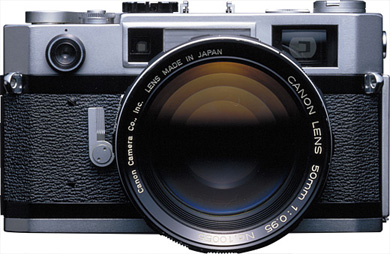 Canon 7(S)
Canon 7(S)
Likely to acquire: low
Canon started out (as far as the west is concerned) making Leica-copy cameras and they did a fine job. By the mid-50s they began going their own way and their cameras looked less like Leicas and more like Canons.
This was the last of their top-tier rangefinders. The 7 came out in 1961, the 7S in 1965. The S replaced the 7's selenium-cell meter with a CdS cell, and added an accessory shoe on top for on-board flash. They were offered with four different lens speeds: ƒ/1.8, ƒ/1.4, ƒ/1.2, ƒ/0.95 (pictured).
After this, Canon puts its rangefinder energy into its mass-market Canonet line.
I'd love to have one of these, even a ƒ/1.8, but prices have always been very high and remain so. Still, I can dream.
Photo from The Canon Camera Museum
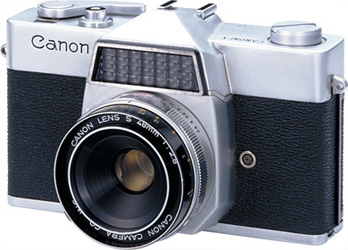 Canon Canonex / Mamiya Auto-Lux
Canon Canonex / Mamiya Auto-Lux
Likely to acquire: medium
I didn't know this camera existed until recently. It's another one of Canon's odd experiments, and they seemed to like have an entry in almost every niche available; if the stereo-realist format had come out ten years later, I'm sure Canon would have made a stereo camera.
This is Canon's fixed-lens, leaf-shutter SLR. I assume its chief competitor was Kowa in this market.
There's an interesting write-up on this camera at a Mamiya-enthusiast's website. It appears there was a joint-development agreement between Canon and Mamiya in the early 1960s, and the result was this camera which was branded as a Canon Canonex and as a Mamiya Auto-Lux 35. There some very minor differences but they are very much the same camera. Exactly which company did what, both in engineering and in manufacturing, is fodder for speculation.
Canons are running around $150 to $250 from what I've seen recently (2022). Mamiyas are about 1/4th the price but I haven't found one that works. This would be a prime example of where I'd willingly buy a broken copy that was far less, simply because the chances that I'd actually use it are very low, but I would definitely want it sitting on my shelf with my other Canon SLRs. My next Canon might actually be a Mamiya.
Photo from The Canon Camera Museum
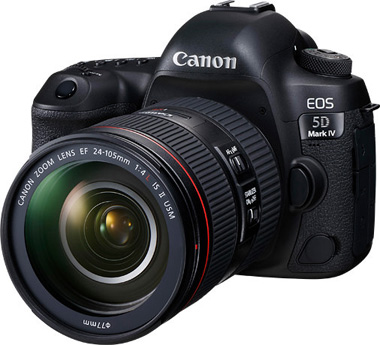 Canon EOS 5D Mk 4 or 5DS R
Canon EOS 5D Mk 4 or 5DS R
Likely to acquire: medium
The EOS 5D and the 5DS R both use full 35mm-frame sensors, as opposed to most of the other EOS cameras which use APS-C size sensors, which are a bit smaller. For me, this means all my lenses act like they're a little longer than I'm used to. A 50mm lens that is "normal" on a full-frame camera acts like an 80mm (short tele) on an APS-C camera. A 135mm is around 210mm. A 35mm lens is the "normal" lens on an APS-C sensor.
That's great for telephoto work, but it comes at the expense of wide-angle. My 28mm would normally be comfortably wide on full-frame, but it's more a 44mm on APS-C. You have to down to 17mm get the equivalent of 28mm on APS-C. I miss having wide angle.
I would likely be happy with either of these, but the current pricing of the 5DS R makes it roughly the same as the 6D Mk 2, but you get a lot more camera with the former. I believe the 5D is still a better camera than the 5DS R, but as has been pointed out a couple places online, for the price difference you could get a 5DS R and a nice L-series lens for the price of the 5D's body alone. I could very easily justify the expense of getting a wide-angle zoom becauase I have nothing shorter than 28mm, or replace either of my other zooms which I think are a bit soft, so that argument carries a lot of weight. We'll see.
Photo from The Canon Camera Museum
.jpg) Canon VI or P
Canon VI or P
Likely to acquire: low
Another Canon rangefinder, this preceeded the 7. I've heard people proununce it as "Vee Eye" but I still believe it's the roman numeral six. As usual, Canon came up with several variants, such as the VT, the VT Deluxe, VL, VL2, VI L and VI-T. Canon also made a P (for Populaire) was downscaled for users who mainly wanted the 35 to 100mm focal range and did not want to pay the full VI price.
I'm not picky about which one I get as long as it has an accessory shoe. I want this camera for the ridiculous reason that I have the accessory clip-on exposure meter for it, and I would like the matched set.
Unfortunately these are very pricey and often broken—usually both at the same time. I have this strange notion that broken cameras should be priced far lower, but I seem to be alone on that.
Photo from The Canon Camera Museum
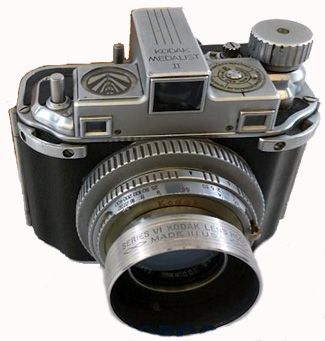 Kodak Medalist
Kodak Medalist
Likely to acquire: low
I have so many junk Kodaks that the idea of having a nice one is always a sweet idea. Actually, I do have a few quality Kodaks, and not just the German ones. I'd set my Kodak Stereo against any Realist-format camera of the time. But most of my Kodak camera experience has been with Brownies, and those are what Kodak pumped out in massive numbers.
So every so often I embrace the idea of getting some quality Kodaks, and the Medalist or Medalist II would scratch the itch nicely. But so would a Super Six-20 or even an Ektra. The problem is that everyone else wants a Medalist too, and prices have been inflated for as long as I can remember, and have never come down.
Photo from Shopgoodwill.com
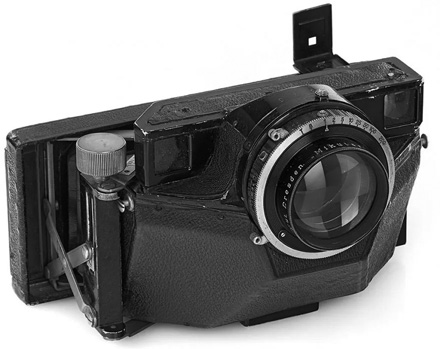 Mikut 3-color Camera and Projector
Mikut 3-color Camera and Projector
Likely to acquire: virtually nil
The Mikut takes three images simultaneously, each passing through a colored filter (red, green, blue) on B&W transparancy film. To view it, you project it through the Mikut projector which also has the three filters, and theoretically you should see a full-color image.
I've wanted one of these since I read an article about it in the June 1936 issue of The Camera magazine. I have no idea what price this fetches, but I safely assume it's astronimical. So while I figure I'll never own one, probably won't even see one in the wild, I do find it fascinating and an interesting idea. There really isn't that much difference between this and Realist-format stereo slides.
Photo from liveauctioneers.com
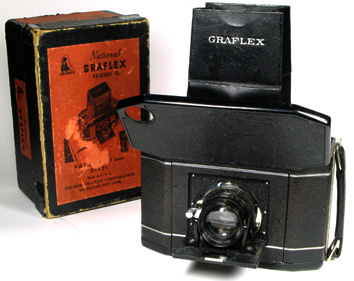 National Graflex
National Graflex
Likely to acquire: medium
In the mid-1950s when the XXX came out, they were called eye-level SLRs to distinguish them from the rest of the SLRs which had waist-level finders.
It's an odd-looking camera. To me it looks like an old-fashioned slide-projector with a waist-level finder. But I have a thing for Graflex cameras; my father had one when I was growing up, and their sheet film cameras are marvels. This was, as far as I know, their only home-grown camera for 120 roll-film (they acquired the Ciro camera company, so I don't count the Ciroflex as home-grown). I have no idea how well it performs or what it's like to use in the field, but I'd love to try.
These are collectible and prices reflect it. Some day I'll either have the money or be lucky enough to blunder on a bargain. Or maybe I'll see one at a shop, handle it, decide it's a turkey and save my money. You never know.
Photo from Silvain Halgand's Collection Appareils.fr
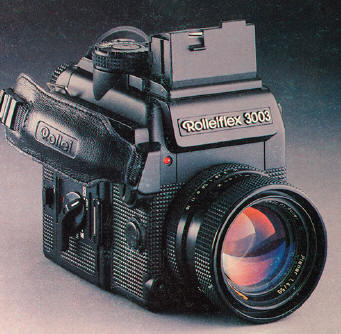 Rolleiflex SL 2000 / 3003
Rolleiflex SL 2000 / 3003
Likely to acquire: low
I remember looking at this thing when it came out and thinking this is the future. It was a 35mm version of what had happened to medium-format cameras. Even though TLRs and Pentax 67s still sold, it seemed like the cutting edge was the brick-shaped Bronicas, Hasselblads and Kowa Sixes. I thought this was the camera to have, this medium-format professional beauty that was scaled down to 35mm.
Of course it was hideously expensive, but of course it would be. Look at it.
This was preceeded by the SL 2000; I don't know enough to discuss the differences. If had the opportunity to get that one, I'd get it. Either would make me happy.
This is another incredible system camera. Interchangable waist- and eye-level finders; film backs that you could change mid-roll; a 4-fps motor-drive (that used to be fast). I believe that the lens mount is the same as the traditional SL35 camera used, which means I already have glass to put on it. Writing about this just makes me feverish for it all over again.
Photo from Mike Butkus (www.butkus.org)
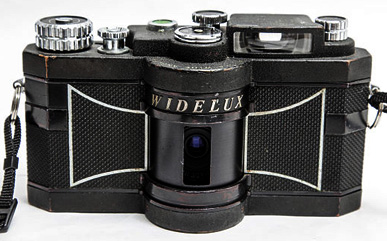 Widelux
Widelux
Likely to acquire: very low
This and the Mikut are the only cameras on this list that are really unique, and they aren't just a variation of something I already have. Even the Nikonos isn't that much different.
I'm drawn to panoramic photos. I don't know why. Sometimes it's the warping that takes place due to the way the image is recorded. Sometimes it's just looking a wide sea of faces of people long gone, be it a World War I military battalion that's about to sent to France, the lifeguards at a beach in 1930, the employees of a long defunct beer brewery downtown. For a short while there was a shop at Laguna Beach that sold B&W prints of old panoramas, but the they closed before I had saved enough pennies to purchase one. I'm still kicking myself because of it.
Some panoramic cameras cheat—they just have a very wide lens and mask off the top and bottom of the image to show a slim but wide aspect ratio. The Widelux does it right: the lens swivels and paints the image across a wide swath of film.
There are a number of sub models of Widelux, and some take 120 film and others 35mm. I'd take what I can get, but they've always been very expensive and as far as I can tell, always will be, which is why I say my chances of getting this are "very low." It's one of the very few cameras where if I did buy one, I'd want it to work no matter what because I would want to try it out. I could see this one finding a home in my primary camera bag.
Photo by Kenneth C. Zirkel
